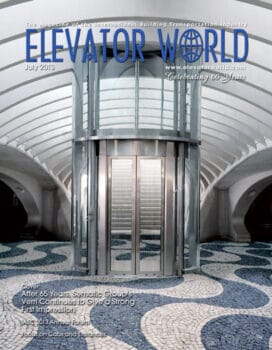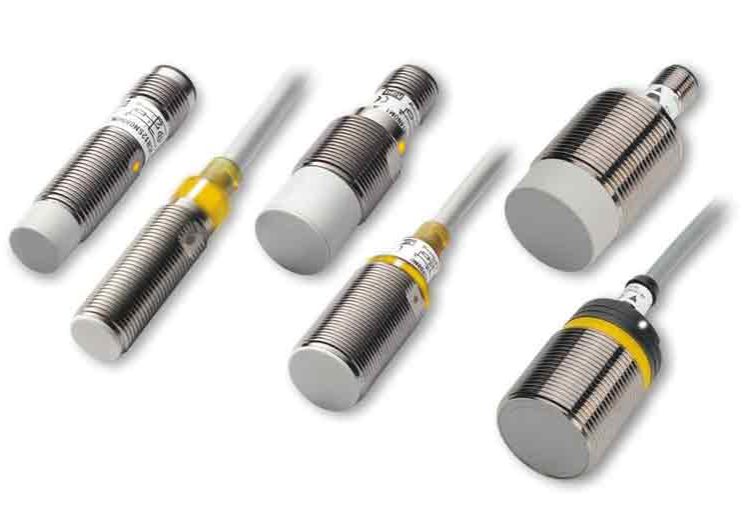SnapCab Partners with International Company Entering North American Market
Jul 1, 2013

Trespa® International, a multinational company based in the Netherlands, considered elevator interiors as a potential new market for its architectural panels in North America. Trespa representative BettyLynn Abercrombie went to the 2011 National Association of Elevator Contractors Exposition specifically to contact SnapCab® to see if they might form an alliance. “I read articles and talked to people inside the elevator industry, and it was apparent that the best match for our purposes was SnapCab,” she said.
From the SnapCab perspective, Caleb Morrison, its vice president, recalls Abercrombie approaching him at the SnapCab booth, samples in hand, extolling the virtues of Trespa’s phenolic panels. Up to that point, SnapCab was unaware of Trespa. In Morrison’s words, “BettyLynn wouldn’t take ‘no’ for an answer. It took a couple of meetings before we fully understood the benefits of offering Trespa. In Europe, Trespa is an industry standard, and it’s well known here among architects and designers, but for us, it was a new product.”
Evan Epstein, SnapCab’s director of Business Development, eventually began working with Abercrombie on several live elevator projects, including one in New York City with more than 300 elevators cabs slated for upgrades. Epstein knew of Trespa in the architectural world but did not think it could be easily brought into the market of elevator interiors.
Compatibility
SnapCab has a patented system for manufacturing elevator interiors, a 15-year record of double-digit growth, a national network of certified installers, a Lean manufacturing facility that could embrace a new concept and the ability to quickly scale up manufacturing and distribution, if required. It was able to modify the manufacturing process of Trespa’s panels by eliminating the need for expensive substrate and the associated manufacturing cost to mount surface materials. This allowed the new elevator interiors to be offered at approximately the same cost as plastic laminate versions.
The SnapCab system can use almost any surface material, as long as it meets code. The company has already installed such materials as glass, stone, exotic wood veneers, stainless steel and plastic laminates. It considered Trespa’s panels particularly well suited for elevator interiors. The inherent antimicrobial properties of Trespa’s Virtuon (without antimicrobial additives) are intended for healthcare environments. The panels are durable, especially in resisting impact. Additionally, they are designed for resistance to wetness and related degradation. Strong stains such as varnishes, ink and aerosol paints can be removed without damage to the material.
Regardless, SnapCab felt the match required some engineering and imagination before the panels could be fully integrated into its manufacturing process. According to company founder Glenn Bostock:
“SnapCab was the magic carpet that got Trespa into elevator interiors. We modified some of our systems and extrusions to accommodate a 3/8-in. panel. We ordered special cutters for our computer numerical control machine and ordered custom screws. The transformation took the better part of a year to develop.”
Perspective
SnapCab began by designing an elevator interior that could be installed in less than a day by elevator maintenance personnel with little to no training. As a result, SnapCab advertising and other marketing activity was directed toward established elevator manufacturing and maintenance companies. While this strategy had been successful in propelling SnapCab to the leadership position in the category it invented, the company felt it had reached the point where it needed to extend its brand to architects and designers to create the demand that could now be handled by its certified installers.
Trespa, on the other hand, had created a network of more than 30 independent sales agencies, employing approximately 60 salespeople focused on getting Trespa specified by architects and designers. Though it made significant inroads into that market over the last 15 years, the sales cycle for its product was measured in years and counted on constant brand awareness. According to Jim Palmer, Interior Account manager for Trespa North America:
“Trespa has elements of form and function that appeal to both architects and designers. SnapCab has established a presence with the contractors that execute specified projects, and building owners and managers.”
The mutual conclusion was that SnapCab could significantly reduce the length of Trespa’s sales cycle in the world of elevators, while Trespa could provide SnapCab with a connection to architects and designers. SnapCab’s certified installers also benefit from this alliance, because with Trespa, they can offer healthcare facilities a highly effective alternative to stainless steel. While non microbial itself, stainless steel must be mounted on a substrate that does not naturally resist microbes. Mold and other dangerous growths can get a foothold in these substrates, which may be subject to dampness and frequent cleaning.
Other intended applications for Trespa’s surfacing material include educational facilities that serve large populations. Additionally, should hard use or accidents mar the surfaces, SnapCab’s system makes replacement of just one panel easy. The product mix also allows architects and designers to match existing themes in vestibules and elevator lobbies. Additionally, because Trespa’s product is only 3/8-in. thick, clear inside cab size is increased by 1/2-in. on each side. This seems like a small reduction but can come in handy when measuring for Americans with Disabilities Act requirements.
Delivery Schedule
Because Trespa panels are manufactured in the Netherlands, SnapCab was concerned about delivery times to its customers in the U.S. However, these were allayed by the nature of this long-term alliance, as Trespa was willing to stock its most popular surface materials at a location close to the SnapCab facility in Bucks County, Pennsylvania. SnapCab feels it can assure its customers of timely delivery in all parts of North America.
Marketing Synergy
SnapCab also created a customized catalog that promoted both Trespa and SnapCab’s patented interior system. This was a real advantage to Trespa, in that the company counts on independent sales agencies to drive much of its business. Palmer notes:
“Having a beautiful catalog to put in the hands of specifiers, as well as tying Trespa in with the SnapCab brand, was a big advantage for us. . . . There’s constant communication between SnapCab business development managers and our agencies.”
The synergy between SnapCab and Trespa has already resulted in many projects for both, including a large remodeling project at the Veterans Affairs Hospital in Loma Linda, California, for 12 elevators that would not have happened without the cooperative effort. According to Palmer, “This is a model that we’ve come to appreciate and taken the concept into other markets. We’re using the same approach, and it seems to be workable across other industries.”
Work in Progress
The SnapCab/Trespa relationship has already resulted in dozens of projects across North America. SnapCab’s approach to elevator interior systems and Trespa’s international reputation in the world of architecture and design appear to be a winning combination.
Trespa® International, a multinational company based in the Netherlands, considered elevator interiors as a potential new market for its architectural panels in North America. Trespa representative BettyLynn Abercrombie went to the 2011 National Association of Elevator Contractors Exposition specifically to contact SnapCab® to see if they might form an alliance. “I read articles and talked to people inside the elevator industry, and it was apparent that the best match for our purposes was SnapCab,” she said.
From the SnapCab perspective, Caleb Morrison, its vice president, recalls Abercrombie approaching him at the SnapCab booth, samples in hand, extolling the virtues of Trespa’s phenolic panels. Up to that point, SnapCab was unaware of Trespa. In Morrison’s words, “BettyLynn wouldn’t take ‘no’ for an answer. It took a couple of meetings before we fully understood the benefits of offering Trespa. In Europe, Trespa is an industry standard, and it’s well known here among architects and designers, but for us, it was a new product.”
Evan Epstein, SnapCab’s director of Business Development, eventually began working with Abercrombie on several live elevator projects, including one in New York City with more than 300 elevators cabs slated for upgrades. Epstein knew of Trespa in the architectural world but did not think it could be easily brought into the market of elevator interiors.
Compatibility
SnapCab has a patented system for manufacturing elevator interiors, a 15-year record of double-digit growth, a national network of certified installers, a Lean manufacturing facility that could embrace a new concept and the ability to quickly scale up manufacturing and distribution, if required. It was able to modify the manufacturing process of Trespa’s panels by eliminating the need for expensive substrate and the associated manufacturing cost to mount surface materials. This allowed the new elevator interiors to be offered at approximately the same cost as plastic laminate versions.
The SnapCab system can use almost any surface material, as long as it meets code. The company has already installed such materials as glass, stone, exotic wood veneers, stainless steel and plastic laminates. It considered Trespa’s panels particularly well suited for elevator interiors. The inherent antimicrobial properties of Trespa’s Virtuon (without antimicrobial additives) are intended for healthcare environments. The panels are durable, especially in resisting impact. Additionally, they are designed for resistance to wetness and related degradation. Strong stains such as varnishes, ink and aerosol paints can be removed without damage to the material.
Regardless, SnapCab felt the match required some engineering and imagination before the panels could be fully integrated into its manufacturing process. According to company founder Glenn Bostock:
“SnapCab was the magic carpet that got Trespa into elevator interiors. We modified some of our systems and extrusions to accommodate a 3/8-in. panel. We ordered special cutters for our computer numerical control machine and ordered custom screws. The transformation took the better part of a year to develop.”
Perspective
SnapCab began by designing an elevator interior that could be installed in less than a day by elevator maintenance personnel with little to no training. As a result, SnapCab advertising and other marketing activity was directed toward established elevator manufacturing and maintenance companies. While this strategy had been successful in propelling SnapCab to the leadership position in the category it invented, the company felt it had reached the point where it needed to extend its brand to architects and designers to create the demand that could now be handled by its certified installers.
Trespa, on the other hand, had created a network of more than 30 independent sales agencies, employing approximately 60 salespeople focused on getting Trespa specified by architects and designers. Though it made significant inroads into that market over the last 15 years, the sales cycle for its product was measured in years and counted on constant brand awareness. According to Jim Palmer, Interior Account manager for Trespa North America:
“Trespa has elements of form and function that appeal to both architects and designers. SnapCab has established a presence with the contractors that execute specified projects, and building owners and managers.”
The mutual conclusion was that SnapCab could significantly reduce the length of Trespa’s sales cycle in the world of elevators, while Trespa could provide SnapCab with a connection to architects and designers. SnapCab’s certified installers also benefit from this alliance, because with Trespa, they can offer healthcare facilities a highly effective alternative to stainless steel. While non microbial itself, stainless steel must be mounted on a substrate that does not naturally resist microbes. Mold and other dangerous growths can get a foothold in these substrates, which may be subject to dampness and frequent cleaning.
Other intended applications for Trespa’s surfacing material include educational facilities that serve large populations. Additionally, should hard use or accidents mar the surfaces, SnapCab’s system makes replacement of just one panel easy. The product mix also allows architects and designers to match existing themes in vestibules and elevator lobbies. Additionally, because Trespa’s product is only 3/8-in. thick, clear inside cab size is increased by 1/2-in. on each side. This seems like a small reduction but can come in handy when measuring for Americans with Disabilities Act requirements.
Delivery Schedule
Because Trespa panels are manufactured in the Netherlands, SnapCab was concerned about delivery times to its customers in the U.S. However, these were allayed by the nature of this long-term alliance, as Trespa was willing to stock its most popular surface materials at a location close to the SnapCab facility in Bucks County, Pennsylvania. SnapCab feels it can assure its customers of timely delivery in all parts of North America.
Marketing Synergy
SnapCab also created a customized catalog that promoted both Trespa and SnapCab’s patented interior system. This was a real advantage to Trespa, in that the company counts on independent sales agencies to drive much of its business. Palmer notes:
“Having a beautiful catalog to put in the hands of specifiers, as well as tying Trespa in with the SnapCab brand, was a big advantage for us. . . . There’s constant communication between SnapCab business development managers and our agencies.”
The synergy between SnapCab and Trespa has already resulted in many projects for both, including a large remodeling project at the Veterans Affairs Hospital in Loma Linda, California, for 12 elevators that would not have happened without the cooperative effort. According to Palmer, “This is a model that we’ve come to appreciate and taken the concept into other markets. We’re using the same approach, and it seems to be workable across other industries.”
Work in Progress
The SnapCab/Trespa relationship has already resulted in dozens of projects across North America. SnapCab’s approach to elevator interior systems and Trespa’s international reputation in the world of architecture and design appear to be a winning combination.
Get more of Elevator World. Sign up for our free e-newsletter.








